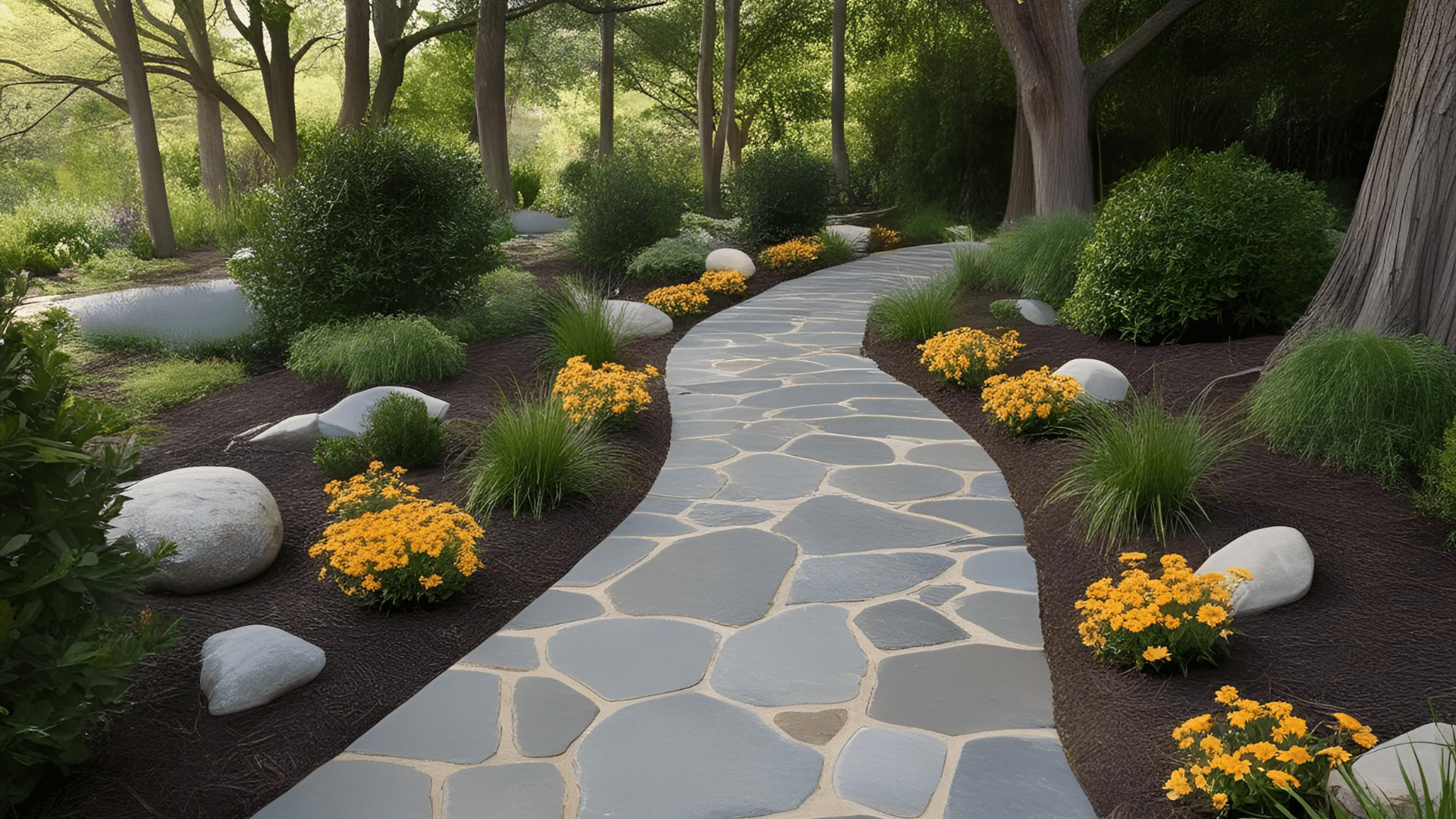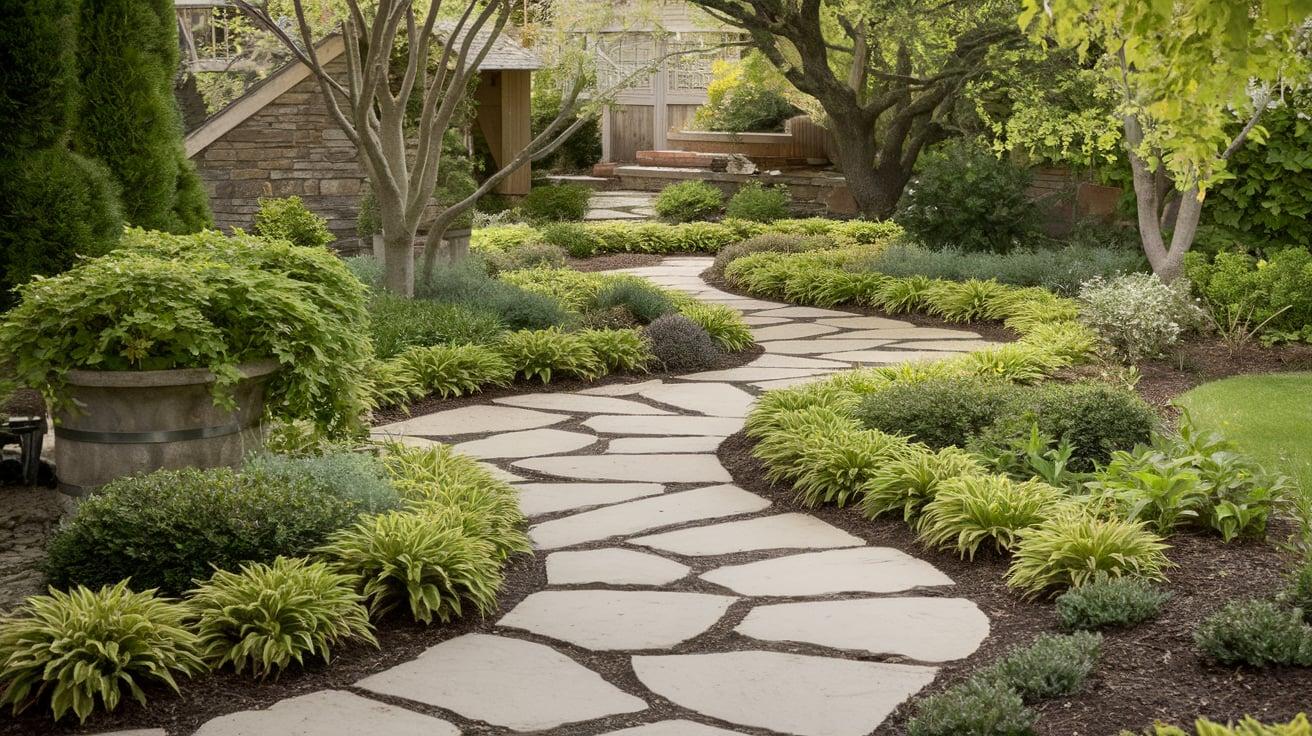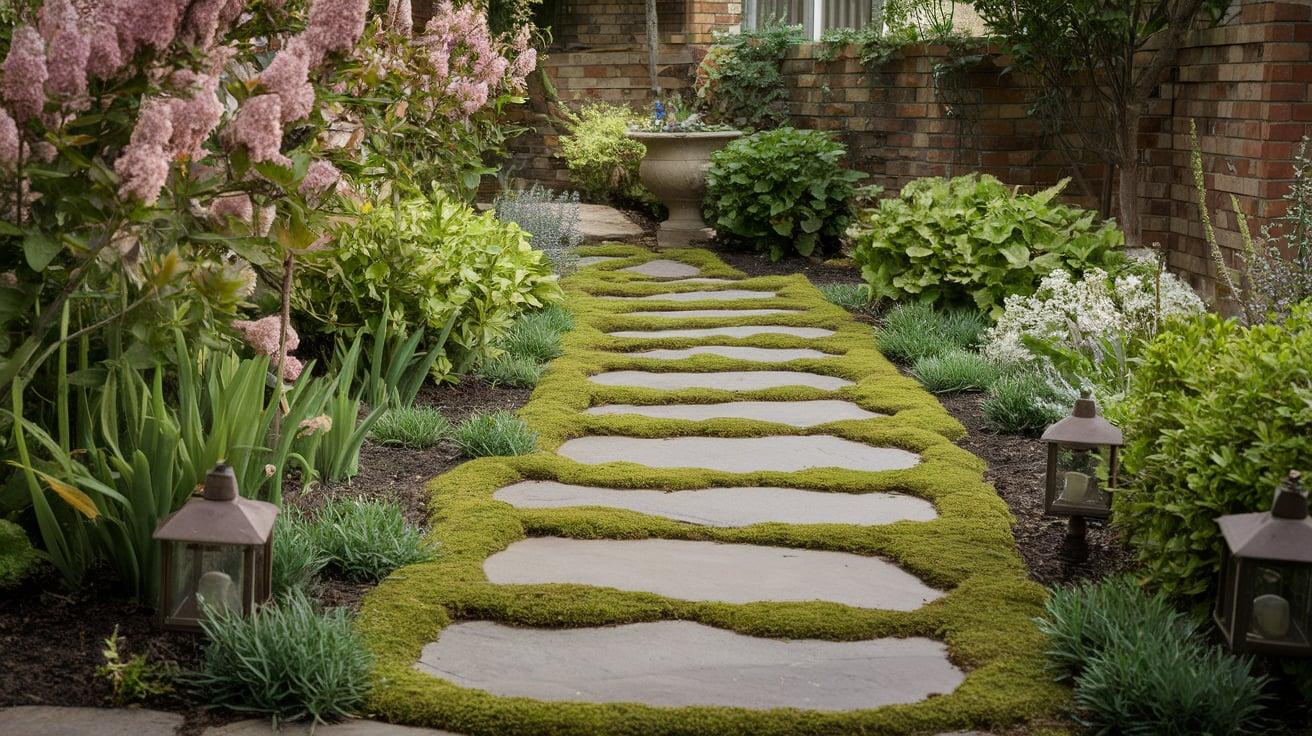Creating a beautiful outdoor space can be challenging. Finding the right materials that look good, last a long time, and don’t require constant attention isn’t easy.
I understand this struggle! A flagstone pathway might be the perfect solution you’re looking for. These natural stone paths add charm and function to any yard while requiring minimal upkeep.
I’ll show you 14 flagstone pathway ideas that can turn your garden into something magical – like walking through a fairytale setting.
You’ll discover how to use different stone shapes, colors, and arrangements to create paths that connect different areas of your yard and become standout features in their own right.
14 Flagstone Pathway Ideas That Feel Like a Fairytale
1. The Winding Garden Spell
A path that curves and turns through your garden creates a sense of wonder. I love how winding flagstone walkways slow down the pace, letting you notice all the small details in your garden.
Place stones in a gentle S-curve and add small plants along the edges. This natural flow makes even a small yard feel bigger and more interesting.
Tip: Keep curves smooth and natural for easy walking and lawn mowing.
2. Enchanted Stairway Path
For yards with slopes, flagstone steps offer both beauty and function. Set each stone firmly into the hillside at varying heights that follow the natural contour of your land.
Plant low-growing flowers between levels to soften the look. When surrounded by greenery, the stones seem to float upward, making a simple climb feel like an adventure.
Safety note: Ensure each stone is firmly secured in the hillside to prevent shifting.
3. Mossy Stepping Stones
Space your flagstones a few inches apart, and let nature work its magic. Over time, moss, creeping thyme, or small ground covers will grow between and around the edges.
This gives your path an aged, established feel—as if it has been there for centuries. The soft green against the earthy stone creates a gentle contrast that looks good in any season.
Maintenance: This option needs less mowing but may require occasional trimming.
4. Archway Entry to Wonderland
Frame the start of your flagstone path with an arch covered in climbing plants. Roses, jasmine, or clematis create a stunning gateway that changes with the seasons.
Walking under this living doorway and onto your stone path feels like stepping into another world. The arch marks a clear transition point in your garden layout.
Structure options: Wood, metal, or vinyl arches all work well with stone paths.
5. Glowing Night Stones
Add small lights along your flagstone path to create evening magic. Solar-powered options need no wiring and charge during the day. You can place them between stones or along the edges.
The soft glow highlights the texture of each stone at night, making your garden usable and beautiful after sunset. Your guests will remember this special touch.
Practical benefit: Makes your garden both beautiful and usable after sunset.
6. Patchwork Mosaic Trail
Mix different flagstone shapes, sizes, and colors to create a one-of-a-kind path. Fit them together like puzzle pieces with small gaps filled with pea gravel or crushed stone.
This playful approach gives your garden path character and visual interest. Each section tells its own story through color and pattern, making the whole walkway feel handcrafted.
Planning tip: Sort stones by thickness before laying to create a more level walking surface.
7. Curved Walk Along the Wall
A flagstone path that follows the curve of a wall or tall hedge creates a sense of safety and discovery. The solid structure on one side guides you forward while hiding what’s ahead.
This design builds anticipation as you walk. Use stones with smooth, rounded edges to keep the flow natural, and plant small flowers along the open side.
Best uses: Great for side yards or garden boundaries.
8. River Rock Accents Between Stones
Instead of soil or plants, fill the spaces between flagstones with smooth river rocks. The contrast between flat pathway stones and rounded pebbles creates a pleasing texture difference. Choose pebbles in colors that match or nicely contrast with your flagstone.
This combination handles water runoff well while looking planned and thoughtful.
Practical benefit: Reduces weeding and maintenance compared to soil-filled gaps.
9. Fairytale Pondside Path
Let your flagstone path run alongside a small pond or water feature. On sunny days, the stones will reflect in the water, doubling their beauty. Position some flagstones at the water’s edge, seeming to float above the surface.
This creates a peaceful spot to pause and watch fish or water plants. The sound of water adds another layer to the path experience.
Design note: Ensure stones near water are level and stable for safety.
10. Cottage Garden Border Trail
Line your flagstone walkway with classic cottage flowers that spill slightly onto the path. Sweet-smelling plants like lavender brush against visitors as they pass. Choose flowers in soft colors that bloom at different times for year-round interest.
The stone provides structure while the informal planting style keeps the mood light and welcoming.
Balance: The stone provides structure while plants keep the mood casual.
11. Secret Corner Path
Design your flagstone path to disappear around a bend, hidden by tall plants or a garden structure. This simple trick builds curiosity and pulls people forward to see what’s next.
The hidden destination might be a bench, bird bath, or small garden art piece. The surprise element makes even daily walks through your garden more interesting.
Placement tip: This works well in larger yards or to connect different garden zones.
12. Rustic Woodland Steps
Use thick, natural-edge flagstones as steps in shaded areas. Set them directly into the soil on sloped sections of your yard, allowing moss to grow on their edges. These rugged steps look like they formed naturally over time.
Keep the surrounding plants woodsy and low-maintenance – ferns, hostas, and native ground covers work well.
Plant partners: Ferns, hostas, and native ground covers work well with this style.
13. Vintage Brick & Stone Blend
Combine flagstones with old bricks for a path with historical charm. The different shapes and textures play well together, especially when you choose stones and bricks in related color families.
This mix-and-match approach feels collected over time rather than installed all at once. The result is a path with depth, character, and a sense of history.
Material tip: Salvaged bricks from old buildings add genuine age and interest.
14. Mini Meadow Path
Set flagstones with wide gaps and allow small flowering plants to grow freely between them. Choices like white clover, violets, or small daisy varieties create a meadow-like effect around your stepping stones.
This soft, natural look changes with the seasons, and the path becomes part of the garden rather than just cutting through it.
Seasonal change: This style looks different throughout the year as plants grow and bloom.
Alternate Takes on a Fairytale Path
- Gravel & Flagstone Fusion – Mix small gravel between wider-spaced flagstones for a budget-friendly path that still captures that magical garden feel.
- Zen-Inspired Flagstone Layouts – Place stones in rhythmic patterns with clean lines and plenty of space between each step for a calm, thoughtful journey through your garden.
- Tiled Inlays with Flagstone Edges – Frame decorative tiles or mosaics with natural flagstone to create focal points along your path that surprise and delight visitors.
- Tree-Surrounding Paths—Create circular flagstone paths around mature trees to make them focal points, protect their roots, and add a sense of woodland wonder.
- Color-Popped Borders – Plant bright flowers like purple salvia or yellow coreopsis along flagstone edges to create vivid color contrasts that make your stone path stand out.
Popular Flagstone Styles to Explore
1. Bluestone Pathways
Bluestone adds a cool, calm look to any walkway. Its blue-gray tones contrast well with plants and flowers. When it rains, the color gets deeper, which adds a nice visual effect. This stone has a slightly rough surface, so it’s safe to walk on even when wet. It’s a good match for modern homes but still brings charm to garden paths.
2. Sandstone Trails
Sandstone comes in warm shades like tan, rust, and honey. These colors give your path a sunny, welcoming feel. Over time, the stone changes slightly, which adds character. Each piece has its pattern, making the path feel more natural. It works well in cottage-style gardens and bright spots.
3. Limestone Looks
Limestone has a clean, smooth surface with soft tones like cream and light gray. These colors help small spaces feel more open. It reflects light gently and creates a calm mood. Limestone paths fit well in formal gardens or next to neat flower beds. It also offers enough grip to stay safe in wet weather.
4. Irregular Flagstones
These stones don’t follow a set shape. Each one is different, so the path feels like it grew there over time. The edges are uneven, which gives a relaxed look. It takes some effort to place them well, but the result feels natural and easygoing. Great for winding paths around trees and plants.
5. Geometric Cuts
These flagstones come in square or rectangular shapes. They create a neat, tidy path with clear lines. You can lay them in patterns like herringbone or brick style. The look is more structured, but the stone keeps it grounded. This style works for gardens that mix old and new elements.
Common Mistakes That Ruin the Magic
| Mistake | Why It Ruins the Magic |
|---|---|
| Overcrowding stones | Takes away the natural, whimsical look and makes the path feel forced |
| Wrong filler materials | Synthetic grout interrupts the organic, earthy aesthetic |
| Forgetting drainage | Creates puddles and mess—definitely not part of a fairytale scene |
| Ignoring scale | Stones that are too big or too small disrupt visual harmony |
| Inconsistent lighting | Breaks the mood and ruins the enchanting nighttime atmosphere |
Conclusion
Creating a flagstone pathway isn’t just about connecting two points in your garden—it’s about crafting an experience. Whether you choose bluestone for its cool elegance or opt for the warm tones of sandstone, your path will tell a story.
The best part? These stone pathways need minimal upkeep yet provide years of beauty. Remember to consider which style matches your garden’s personality and your home’s architecture.
Take time to plan the route, thinking about how it flows with your landscape and where it leads. A well-designed flagstone path does more than guide footsteps—it transforms ordinary moments into little adventures right in your yard.
Ready to create your own fairytale path? The first stone awaits.
Frequently Asked Questions
1. Can I Lay Flagstone Directly on Dirt?
For a stable path, place flagstones on a 2-3 inch base of sand or gravel instead of directly on soil.
2. How Much Does a Flagstone Path Cost?
Flagstone typically costs between $15-30 per square foot, including materials and installation.
3. Do Flagstone Paths Need Sealing?
Sealing is optional but can help prevent staining and extend the life of your path, especially in harsh weather areas.























